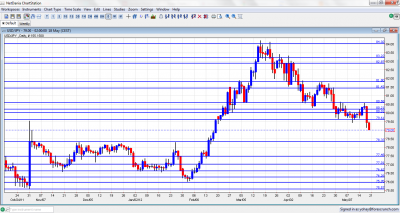Dollar/yen fell off a cliff as safe haven flows poured into the yen. Will we see an intervention at these levels? The rate decision is the major event for this week. Here’s an outlook for the Japanese events and an updated technical analysis for USD/JPY.
Japan’s preliminary gross domestic product figures were better than predicted in the first quarter of 2012 jumping 1.0% from a flat growth rate in the last quarter of 2011 indicating a nice growth trend in the Japanese economy. The annualized growth is estimated at 4.1% for 2012. Domestic demand was the main cause for GDP expansion.
Updates: All Industries Activity disappointed the markets, dropping by 0.3%. The market estimate called for a 0.1% increase. USD/JPY is below the 80 line, and was trading at 79.28. Trade Balance figures will be released on Tuesday. The previous reading was very weak, coming in with a deficit of 0.60T. The markets are not forecasting any change for the May reading. The yen has weakened, as USD/JPY moves closer to the pivotal 80 level. The pair was trading at 0.7971. April’s Trade Balance deficit was much improved from the April reading. The indicator came in at -0.48T, well above the forecast of -0.60T. As expected, the BOJ left its key interest rate untouched, at under 0.1%. USD/JPY was down slightly, trading at 79.38. Bank of Japan Governor Masaaki Shirakawa said the central bank will utilize QE to combat deflation. Core CPI will be released later on Thursday.
USD/JPY daily chart with support and resistance lines on it. Click to enlarge:
Let’s Start:
- All Industries Activity: Monday, 4:30. All industry activity index improved in February with a 0.1% decline, following 1.0% drop in January Analysts expected the index to remain unchanged. All industries activity us predicted to remain unchanged this time.
- Trade Balance: Tuesday, 23:50. Adjusted Merchandise Trade Balance deficit increased to ¥-621.3 billion compared with a previous surplus of 313.2 billion yen revised to deficit of 321.4. Economists expected a smaller deficit of 440. Japanese economy is expected to grow 2% this year, while Yen is predicted to decline after the rising in stimulus plans by BOJ in February. A smaller deficit of ¥600 billion is predicted now.
- Rate decision: Wednesday. The Bank of Japan decided on further easing measures in its last rate decision meeting in order to help the Japanese economy recover from deflation and boost growth. The central bank raised the asset purchase program to 40 trillion yen ($494 billion) from 30 trillion yen. This is the second rise in two months suggesting the BOJ responded to political pressure to fight deflation. No change in rate is forecasted now.
- BOJ Monthly Report: Thursday, 5:00. The Bank of Japan declared in its last monetary report, that domestic conditions are in the rise and will continue to improve however despite signs of recovery economic activity remains flat.
- Tokyo Core CPI: Thursday, 23:30.Tokyo’s core consumer price inflation dropped more-than-expected in April with a 0.5% drop compared to 0.3% decline in the previous month. Economists expected a 0.3% decrease. Another 0.5% decline is anticipated now.
* All times are GMT
USD/JPY Technical Analysis
$/yen remained in range and then even climbed above the round 80 line (mentioned last week) and stayed there. Towards the end of the week, the pair dived and closed in low ground: 79.
Technical lines from top to bottom
We start from lower ground this time. 82.87 was the line where the BOJ intervened in September 2010, and also worked in both directions afterwards. It worked as support when the pair traded higher and remains a cap. 81.80 served as support for the pair at the end of March 2012 and is now strong resistance after capping the pair also in mid April in more than one instance.
Further below 81.43 is stronger after serving as resistance for a recovery attempt. 80.60 provided support for the pair around the same time, and served as a bouncing spot for the next moves.
80.20 is the updated version of the 80.30 line, after separating ranges in May 2012. The round number of 80 is psychologically important, but the pair shattered it recently and it is now minor.
79.60 was a double bottom in May 2012 but now switches to resistance after the fall. 78.30 capped a second recovery attempt in November, after the intervention and had an important role earlier as well, working as support. It is a key point on the downside.
77.50 was the bottom border of a range the pair had at the end of 2011. It is followed by 77, which is only minor support.
76.60 was a cushion for the pair at the beginning of the year and is rather strong. 76.26 is the next line on the downside after working as a support quite some time ago.
75.95 was an all time low and was the catapult for the pair’s rally during 2012. The current all-time low of 75.57 is the last line for now.
I am bullish on USD/JPY.
The weak Philly Fed Index in the US was the trigger for the fall. At these levels, the pair certainly has room for rises, even if we don’t see an open intervention by the BOJ. A stealth intervention is also on the cards. The downside risks come from Europe, as always.
Another note: USD/JPY so far justifies its title as the most predictable currency pair for Q2.
Further reading:
- For a broad view of all the week’s major events worldwide, read the USD outlook.
- For EUR/USD, check out the Euro to Dollar forecast.
- For GBP/USD (cable), look into the British Pound forecast.
- For the Australian dollar (Aussie), check out the AUD to USD forecast.
- For the New Zealand Dollar (kiwi), read the NZD forecast.
- For USD/CAD (loonie), check out the Canadian dollar forecast
- For the Swiss Franc, see the USD/CHF forecast.
